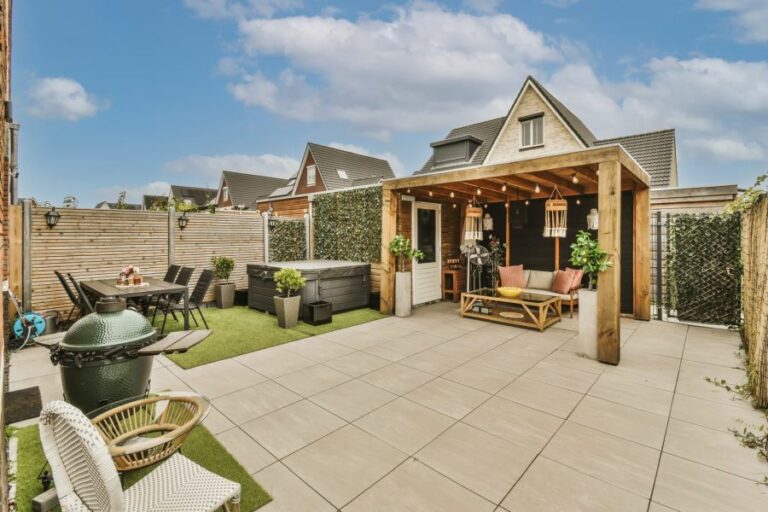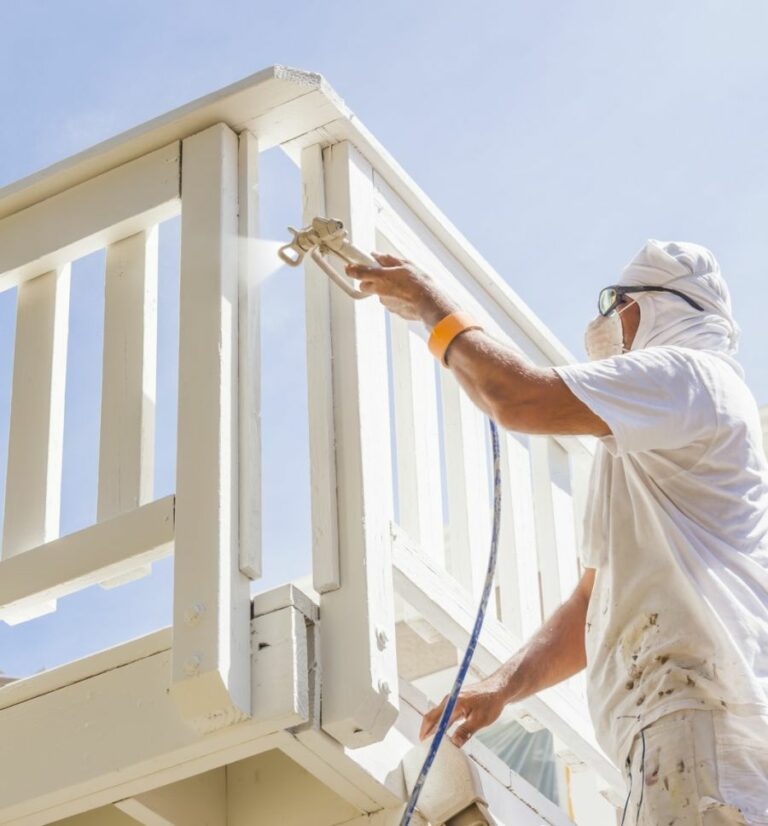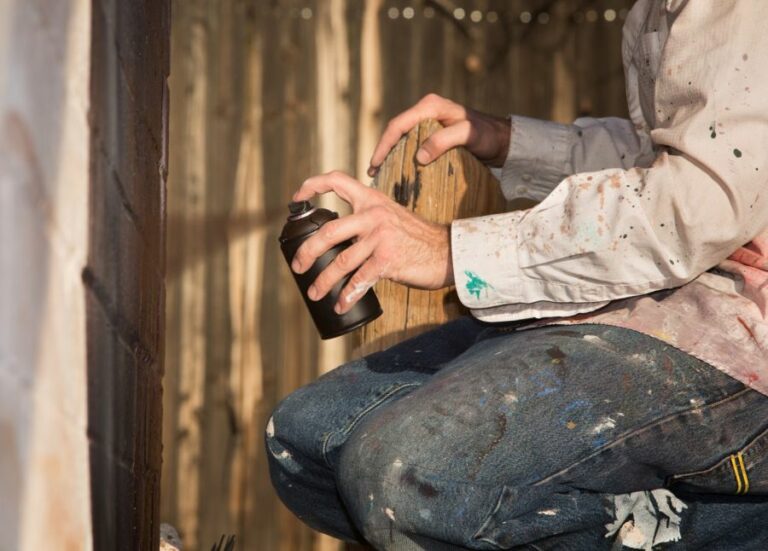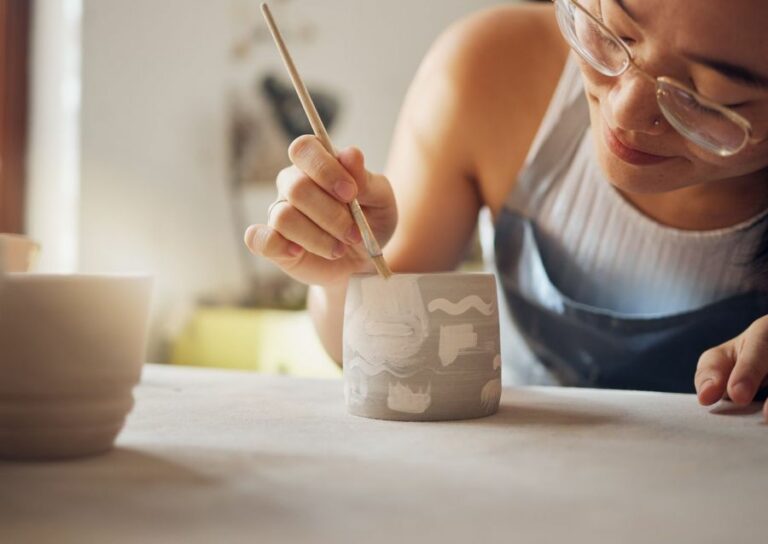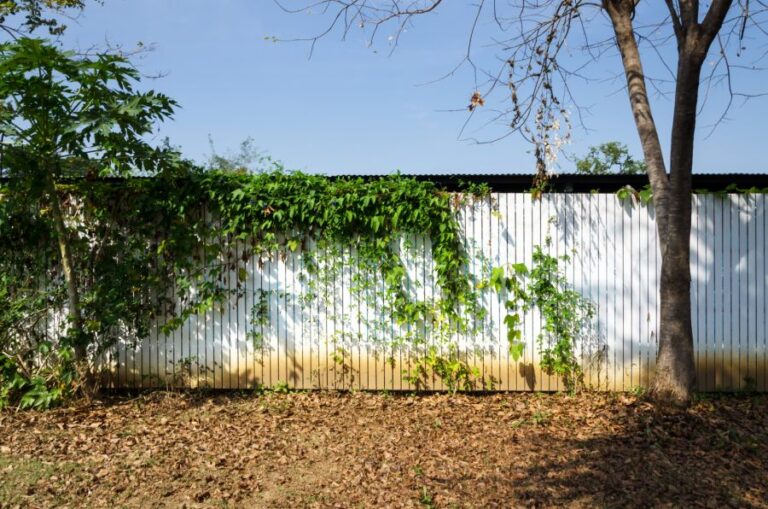Outdoor Brick Wall Paint Ideas, 25 Things You Should Know
Thinking about giving that boring outdoor brick wall a fresh and exciting makeover? Look no further. We have the perfect outdoor brick wall paint ideas that will transform your space in no time. Our carefully selected paint ideas combined with your personal touch will breathe life into your wall, making it the envy of the neighborhood. Let’s dive right in and get those creative juices flowing to turn your ordinary wall into something spectacular.
Outdoor brick wall paint ideas:
Outdoor brick wall paint ideas include classic white, bold and contemporary black or dark grey, vibrant and inviting colorful options, rustic whitewashed or limewashed, and multi-tone effects with accent colors. When choosing paint, consider your climate and wall condition, and use masonry paint designed for exterior brick surfaces.

Looking to spruce up your outdoor brick walls with a fresh coat of paint? Dive into our collection of inspiring paint ideas and give your garden or patio an instant, eye-catching makeover. Read on to discover how you can transform your exterior space with a brush and creativity!
Contents
- 1 Creative Exterior Brick Wall Painting Ideas for Outdoor Spaces
- 2 Identifying the Optimal Paint Type for Exterior Brick Walls
- 3 Which Type of Paint is Best Suited for Outdoor Brick Surfaces?
- 4 How can I enhance the appearance of my exterior brick walls for an improved aesthetic appeal?
- 5 Is it a Good Idea to Paint the Exterior Surface of a Brick Building?
Creative Exterior Brick Wall Painting Ideas for Outdoor Spaces
An outdoor brick wall can be an excellent focal point for your property or a canvas for showcasing your personality and style.
• Fundamental Factors to Consider
Before getting into specific paint ideas, it’s essential to consider some primary factors when selecting the right paint for your outdoor brick wall.
– Climate
When choosing paint for an outdoor brick wall, consider the climate in which you live. If you reside in an area with extreme heat or cold, you should select a specialty paint designed to withstand those particular weather conditions.
For instance, masonry paint is formulated specifically for brick surfaces and offers additional protection against harsh weather.
The US Department of Energy provides information on different types of insulation, including masonry coatings, for climates across the country.
– Wall Condition
It’s also crucial to evaluate the condition of your brick wall before you start painting. Look for signs of damage, such as cracks, deteriorating mortar, or efflorescence (white residue on brick surfaces). Repair any existing damage before painting to ensure the longevity and quality of your final result.
• Popular Paint Ideas for Outdoor Brick Walls
With these factors in mind, now let’s explore some popular paint ideas for outdoor brick walls.
1. Classic Elegance: White Brick Walls
One of the most timeless and versatile paint options for an outdoor brick wall is white. A white brick wall lends a pristine, sophisticated look to your space, instantly elevating its appearance. This versatile choice pairs well with a variety of architectural styles and landscaping themes.
Choose a high-quality masonry paint in a shade of pure white, or experiment with off-white shades until you find the perfect hue. Remember to use a primer designed for exterior brick surfaces to ensure excellent adhesion and coverage.
2. Bold and Contemporary: Black or Dark Grey
For a modern and bold look, consider painting your outdoor brick wall black or dark grey. This sleek and edgy painting idea can make a powerful statement and create a unique ambiance.
Black or dark grey brick walls look particularly stunning when contrasted with wood elements, bright green foliage, or pops of color in your outdoor decor.
High-quality masonry paint in black or dark grey will offer excellent coverage and durability. Be sure to use a primer specifically designed for brick surfaces, and consider finishing with a sealant to help protect against moisture infiltration and fading from UV exposure.
3. Vibrant and Inviting: Colorful Brick Walls
If you want a bright, cheerful look for your outdoor space, consider painting your brick wall in a color that reflects your personality and style.
Whether you’re inspired by the hues of your gardening masterpiece or your favorite sports team’s colors, painting your brick wall in a vivid color can transform your backyard into a lively and inviting oasis.
When choosing a bold color, opt for a high-quality, exterior-grade paint designed for masonry surfaces. Remember that using lighter shades as a primer can promote better coverage and provide a more even final appearance.
4. Rustic Charm: Whitewashed or Limewashed Brick
For a rustic and charming look, consider whitewashing or limewashing your outdoor brick wall. This painting technique creates a slightly weathered, antique effect and can add visual interest and texture to your space.
Whitewashing involves diluting white paint and applying it to the brick surface while limewashing utilizes a mixture of water, lime, and pigment.
Both methods impregnate the brick with color while still allowing the natural variation and texture of the brick to shine through. This paint idea pairs well with a variety of decorating styles, including farmhouse, cottage, and Mediterranean.
• Multi-Tone Effects: Paint and Accent
A final paint idea to consider for your outdoor brick wall is a multi-tone effect. This involves choosing a primary paint color for the majority of the wall, then using an accent color on specific bricks or sections to create a pattern or highlight certain features.
This approach can be both visually appealing and a perfect way to showcase architectural details, such as arches or decorative brickwork.
When selecting colors for a multi-tone effect, consider complementary colors or various shades of the same color. Remember to use masonry paint and a primer specific to exterior brick surfaces for the best results.
In conclusion, there are countless outdoor brick wall paint ideas to choose from, whether you prefer classic elegance, bold and contemporary, vibrant and inviting, rustic charm, or a unique multi-tone effect.
By considering the climate and wall condition and selecting the appropriate paint and technique, you can achieve a beautiful, long-lasting result that enhances your outdoor living space.
Paint Idea | Description |
|---|---|
Whitewash | Creates a classic, weathered aesthetic while allowing the brick texture to show through. |
Neutral Gray | A versatile and timeless color that complements various architectural styles and green landscaping. |
Navy Blue | Welcome a bold and sophisticated look with this dark hue, perfect for ensuring contrast in lighter spaces. |
Sage Green | This subdued color adds serene outdoorsy vibes while blending well with natural surroundings. |
Charcoal Black | Make an eye-catching statement with black paint, featuring a modern and dramatic appearance. |
Terracotta | Add warmth and a touch of Mediterranean flair to your outdoor brick wall with this earthy color. |
Two-tone Color Scheme | Experiment with different combinations of complementary colors to create stunning and unique designs. |
Stencil Art | Include patterned stencil designs over your painted brick wall for an artistic custom vibe. |
Identifying the Optimal Paint Type for Exterior Brick Walls
When it comes to painting outdoor brick walls, the type of paint you choose significantly influences the overall durability and appearance of the finish.
• Acrylic Latex Paint
Perhaps the most popular paint for outdoor brick walls, acrylic latex paint offers several advantages for this type of surface. It provides excellent adhesion and is highly resistant to harsh weather conditions.
– Pros
- Water-based: This type of paint is easy to clean up with soap and water, making the application and clean-up process more convenient.
- Quick-drying: Acrylic latex paint dries relatively fast, so you can apply additional coats within a short period.
- Flexible: This paint expands and contracts in response to temperature fluctuations, reducing the likelihood of chipping and peeling.
- Breathable: It allows vapor to escape, preventing moisture buildup and related problems such as mold and mildew.
– Cons
- Less color longevity: The pigments in acrylic latex paint may fade more quickly than in other types of paint, although high-quality formulas can minimize this issue.
To ensure the best results, it’s essential to clean the brick surface thoroughly and use a quality primer before applying acrylic latex paint. I recommend using a primer specifically designed for masonry surfaces.
• Elastomeric Paint
Elastomeric paint is another popular option when it comes to painting outdoor brick walls. This highly durable paint creates a thick, flexible layer that offers added protection against weather-related damage.
– Pros
- Increased durability: Elastomeric paint’s texture and elasticity make it highly resistant to cracking, fading, and peeling caused by harsh weather conditions.
- Waterproof: This type of paint effectively seals small cracks and gaps in the brick, providing an additional layer of water resistance.
- Insulation: The thick coating of elastomeric paint can also provide a degree of insulation, helping to reduce energy consumption.
– Cons
- Cost: Elastomeric paint is typically more expensive than other types of paint, but its durability can make it a worthwhile investment.
- Thickness: This paint’s thickness can make the application process more challenging, necessitating the use of specific tools and techniques.
• Silicate Mineral Paint
Another excellent choice for outdoor brick walls is silicate mineral paint. This paint forms a durable and breathable layer that bonds well with the brick and lasts for many years.
– Pros
- Highly breathable: Silicate mineral paint allows moisture to evaporate from the brick, reducing the risk of water damage and related issues.
- Durable: This type of paint resists fading and is long-lasting, making it an excellent choice for exterior brick surfaces.
- Environmentally friendly: Silicate mineral paint is made from naturally occurring minerals, making it a more eco-friendly option than other types of paint.
– Cons
- Limited color options: Silicate mineral paint is typically available in a smaller range of colors than other paints.
- Cost: This paint can be more expensive than other options, but its longevity and durability make it a worthwhile investment.
• Conclusion
In conclusion, the best paint for outdoor brick walls largely depends on your specific requirements and budget.
Acrylic latex paint is an excellent choice for its ease of application and versatility, while elastomeric paint offers increased durability and water resistance. For a more eco-friendly and long-lasting option, consider silicate mineral paint.
Regardless of the paint you choose, properly preparing the brick surface and using a quality primer will ensure the finished result is not only aesthetically pleasing but also long-lasting and durable.
Paint Type | Advantages | Disadvantages |
|---|---|---|
Acrylic Latex Paint | Durable, long-lasting, easy to clean, low odor, environmentally friendly | Less breathable than other options, potentially leading to moisture problems |
Silicate Paint | Highly breathable, long-lasting, resistant to mold and mildew, bonds with brick surface | More expensive, requires a specific type of primer, limited color options |
Lime Wash | Natural, breathable, environmentally friendly, creates a unique patina over time | Requires regular maintenance, less durable, may not provide full coverage on certain bricks |
Masonry Paint | Designed specifically for brick surfaces, water-resistant, helps reduce heat loss | May peel or blister over time, can be difficult to remove |
Which Type of Paint is Best Suited for Outdoor Brick Surfaces?
Brick has long been a popular choice for building exterior walls, but like any other construction material, it can start to look weathered and worn over time. Painting your outdoor brick surfaces provides protection and improves their overall appearance.
However, choosing the right type of paint is crucial to ensure a long-lasting, professional-looking result.
• Types of Paint for Outdoor Brick Surfaces
When it comes to choosing paint for outdoor brick, there are three main types of paint that are recommended: acrylic, mineral-based, and elastomeric paint. Each type offers unique benefits, and understanding these will help you make an informed decision for your project.
– Acrylic Paint
Acrylic paint is a water-based paint that is easy to clean up and has excellent durability. It allows for good breathability and is resistant to both chipping and peeling. Acrylic paint works well on brick surfaces because it bonds well to the porous material, ensuring long-lasting coverage.
One of the most popular acrylic paints for exterior brick surfaces is masonry paint. This type of paint is specifically designed for use on porous surfaces like brick, as it contains additives that enhance its breathability and water resistance, making it better suited for outdoor use.
– Mineral-Based Paint
Mineral-based paint, also known as silicate paint or mineral paint, is made from natural ingredients like potassium silicate and mineral pigments. This type of paint forms a chemical bond with the brick surface, creating a durable coating that is highly resistant to weathering, fading, and water infiltration.
Mineral-based paint offers excellent breathability, allowing moisture to escape from the brick, which is essential in preventing damage from trapped moisture.
One of the advantages of mineral-based paint is its ability to maintain the natural texture of the brick, as it has a very fine and tight finish coat. This is a popular choice for those who want to preserve the authentic appearance of their brick surfaces.
– Elastomeric Paint
Elastomeric paint is a high-performance, water-based paint known for its excellent flexibility and weather resistance. It forms a thick, rubber-like coating that can bridge hairline cracks and expand and contract with the brick during temperature fluctuations.
Elastomeric paint also provides superior water resistance, making it an excellent choice for protecting brick surfaces from moisture damage in areas with heavy rainfall or high humidity.
However, elastomeric paint is less breathable than acrylic and mineral-based paints, so it is essential to ensure that the brick is adequately protected against moisture before using this type of paint.
• Preparing the Brick Surface for Painting
Proper surface preparation is key to a successful paint job. Follow these steps to ensure your outdoor brick surface is ready for painting:
- Clean the surface: Thoroughly clean the brick to remove dirt, grime, algae, or mold using a pressure washer or a stiff-bristle brush and a solution of water and mild detergent. Allow the brick to dry completely before proceeding.
- Repair damaged areas: Inspect the brick and mortar for any cracks, loose bricks, or crumbling mortar joints. Use a masonry repair compound or masonry caulk to make the necessary repairs, following the manufacturer’s instructions. Allow the repairs to cure fully before painting.
- Apply a primer: Applying a quality masonry primer is crucial as it helps the paint adhere to the brick surface and increases the paint’s durability. Use a brush or roller to apply the primer, allowing it to dry according to the manufacturer’s recommendations before applying paint.
• Painting Your Outdoor Brick Surface
When it comes to painting your prepared brick surface, follow these tips to ensure a professional result:
- Choose the appropriate paint: As discussed earlier, decide between acrylic, mineral-based, or elastomeric paint based on your desired finish, weather resistance, and breathability needs.
- Select a color: Choose a color that complements the overall design of your home and consider neighboring homes to ensure cohesion within the area. Light colors generally work well on exterior brick, as they help to reflect sunlight and can make your home appear larger.
- Apply the paint: Use a brush, roller, or paint sprayer to apply the paint, working in small sections to ensure even coverage. Start from the top and work your way down the wall. Apply two coats of paint, allowing sufficient drying time between coats as per the manufacturer’s recommendations.
- Protect the paint: To prolong the life of your new paint job, consider applying a clear masonry sealer, especially in areas with harsh weather conditions or high pollution levels.
In conclusion, painting your outdoor brick surfaces can improve their appearance and provide added protection from the elements.
By understanding the different types of paint available, carefully preparing your brick surface, and following the necessary painting steps, you can achieve a long-lasting, professional-looking result that enhances your home’s curb appeal.
How can I enhance the appearance of my exterior brick walls for an improved aesthetic appeal?
Exterior brick walls are a timeless and classic feature for any home. Over time, however, these walls may become worn and weathered, losing their natural beauty. With proper care and maintenance, exterior brick walls can last for centuries, providing both structural integrity and aesthetic appeal.
• 1. Cleaning your brick walls
The natural beauty of brick can be lost due to the accumulation of dirt, grime, and mold. Cleaning is the first step to making your exterior brick walls look better. There are several methods to clean brick surfaces, depending on the level of dirt and type of stains.
– Gentle Cleaning Methods
For regular cleaning, mild cleaning agents like water and mild detergent soap can be used. Use a soft-bristled brush to gently scrub the surfaces, focusing on the most stained areas. Rinse thoroughly with water after cleaning.
If the dirt and grime are more stubborn, a low-pressure wash can be used. Ensure the pressure is kept low to avoid damaging the brick-and-mortar joints.
– Heavy-duty cleaning methods
If the stains on your brick walls include efflorescence or plant growth, more potent cleaning solutions and stronger methods may be necessary.
Muriatic acid can be used for these situations. Apply diluted muriatic acid on the affected areas after ensuring necessary safety precautions have been taken. Rinse thoroughly with water after cleaning.
• 2. Repairing the mortar joints
Damaged mortar joints can lead to increased moisture penetration and further deterioration of your brick walls. Repairing the mortar joints, a process known as repointing will make your walls more structurally sound and aesthetically appealing.
– Identifying the type of mortar
Before you begin repointing, it is crucial to identify the type of mortar used originally. Using a different type may lead to a mismatched appearance and possible damage.
– Repointing process
Repointing involves removing the damaged mortar from the joints and replacing it with new mortar. Use a chisel or grinder to remove the old mortar without damaging the bricks.
Mix the new mortar according to the correct proportions and apply it to the joints using a trowel. Smooth the surface of the mortar and allow it to cure.
• 3. Protective sealants
Applying a protective sealant can help protect your exterior brick walls from various external factors, such as weather, moisture, and pollution.
– Choosing the right sealant
To choose the right sealant, it is crucial to consider the permeability of the brick surface. The sealant should allow moisture vapor to escape while preventing liquid water from entering. For this reason, most experts recommend silane or siloxane-based sealants.
– Applying the sealant
Ensure that the brick wall is clean and completely dried before applying the sealant. Follow the manufacturer’s instructions for the application process, which typically involves spraying or rolling on the product. Allow the sealant to dry and cure according to the guidelines provided.
• 4. Paint and stain options
Another way to make your exterior brick walls look better is by applying paint or stain. These options can enhance the appearance of the wall while providing additional protection.
– Painting brick walls
Painting is an effective way to give your brick walls a fresh and modern look. Before painting, the brick must be clean, dry, and free from any loose or peeling paint.
Apply a quality primer formulated for masonry surfaces to ensure proper adhesion. Then, choose a water-resistant, breathable paint to apply to the brick surface.
– Staining brick walls
Staining offers the benefit of retaining the natural texture of the brick while giving it a new color. Brick stains are typically water-based and can be applied using a low-pressure sprayer or a paintbrush. Follow the manufacturer’s instructions for proper application techniques and drying times.
• 5. Regular maintenance
Regular maintenance will help you keep your exterior brick walls looking their best and provide lasting durability.
- Inspect your walls periodically for signs of damage, such as cracked bricks or deteriorated mortar joints.
- Keep gutters and downspouts clear and free from debris to prevent water from seeping into the brick walls.
- Regularly clean the brick surfaces, as discussed earlier in this article.
- Check for any growth of vines or other plant life on the walls as these can cause damage by trapping moisture against the brick or widening cracks.
By following these recommendations and investing time in regular maintenance, you can make your exterior brick walls look better and ensure their longevity for years to come.
Is it a Good Idea to Paint the Exterior Surface of a Brick Building?
Painting exterior brick is a popular topic among homeowners who are looking to update the exterior appearance of their homes. While there is no definitive answer to whether or not painting exterior brick is a good idea, there are several factors to consider before making a decision.
• Benefits of Painting Exterior Brick
– Improved Aesthetics
One of the primary reasons homeowners choose to paint their brick exteriors is to improve the appearance of their homes. Over time, brick can become discolored, stained, or otherwise unattractive due to exposure to the elements, dirt, and pollution.
Painting the brick can create a more uniform, clean appearance and enhance the home’s overall curb appeal.
– Added Protection
Aside from the aesthetic improvement, painting exterior brick can also provide added protection to the brick surface. The paint acts as a sealing layer, protecting the brick from water absorption and potential damage caused by freezing and thawing cycles.
Furthermore, it can also protect against the growth of mold and mildew on the brick surface.
– Color Customization
One of the advantages of painting exterior brick is the ability to customize the color to suit the homeowner’s personal style and preferences. With a wide range of paint colors available, homeowners can choose a color that complements their existing landscaping and overall design aesthetic.
• Drawbacks of Painting Exterior Brick
– Long-term Commitment
When deciding to paint exterior brick, it’s important to understand that this is a long-term commitment. Paint is difficult to remove from brick surfaces, and it can be costly and time-consuming to return the brick to its original appearance should the homeowner change their mind in the future.
Additionally, regular maintenance may be required, including repainting every few years to maintain a fresh and clean appearance.
– Reduced Breathability
Brick is a porous material, which means moisture can easily pass through the surface. When paint is applied to brick, it can reduce the permeability, resulting in trapped moisture within the brick. This trapped moisture can lead to damage such as spalling, efflorescence, or even structural failure over time.
Additionally, decreased breathability can cause paint to blister, peel, or crack as moisture attempts to escape the brick.
– Potential for Damage
While painting exterior brick can provide a protective layer, using the appropriate paint and following proper application techniques is essential.
Using the wrong paint or applying it improperly can ultimately cause more harm than good, leading to blistering, peeling, or a prematurely failing paint job. It’s important to consult with professionals or research suitable paint for exterior brick.
• Alternative Solutions
If painting exterior brick is not suitable for your home or if you’re looking for less permanent solutions, consider these alternatives:
– Brick Staining
Brick staining is a method of applying a semi-transparent, permanent color to the brick surface without the use of paint. This low-maintenance, breathable coating maintains the texture of the brick while enhancing the color.
It’s an increasingly popular choice among homeowners who want to update the appearance of their exterior brick without the commitment and drawbacks of painting.
– Brick Cleaning and Sealing
If the primary goal is to refresh the appearance of the brick, consider professional cleaning and sealing services. Cleaning can remove debris, dirt, mold, and mildew buildup and help restore the original color and beauty of the brick.
Sealing the brick after cleaning can provide added protection against the elements while ensuring breathability.
– Cosmetic Updates
If you’re not ready to commit to an extensive project, consider making cosmetic updates to the exterior of your home to enhance its appearance. These updates may include new landscaping, updating light fixtures or front door hardware, or adding shutters or window boxes for a fresh pop of color.
In conclusion, painting exterior brick can be a good idea for certain situations, such as improving aesthetics, added protection, and color customization.
However, there are several drawbacks to consider, including the long-term commitment, reduced breathability, and potential for damage. It’s essential to weigh these factors and consider alternative solutions to make an informed decision that best suits your home and design preferences.

